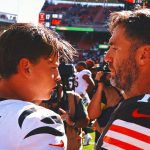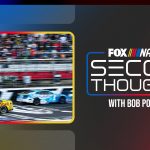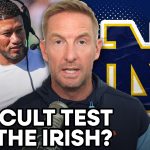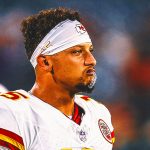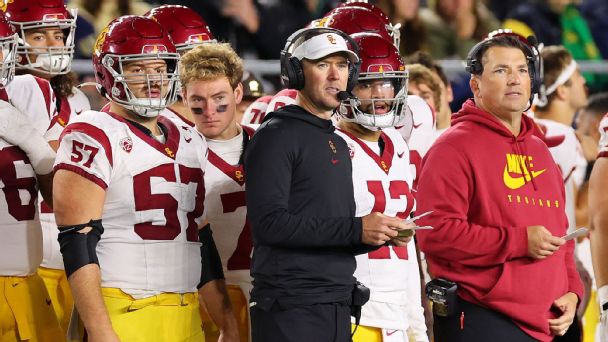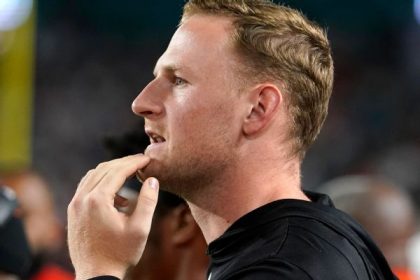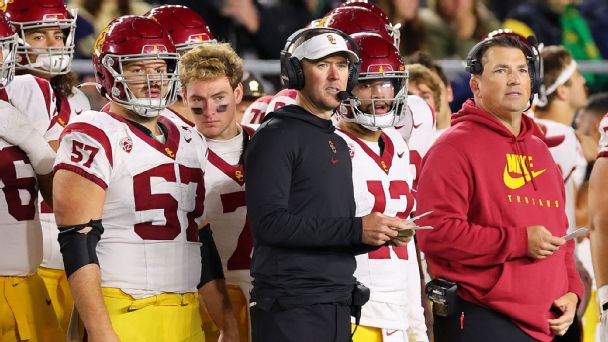
IF THERE IS a feeling of déjà vu around USC this week, it’s rooted in a harsh reality.
For the second season in a row under Lincoln Riley, USC won its first six games of the season only to drop its seventh. There are similarities: Both losses were on the road, both came after dominant offensive starts to the season and questionable defensive performances. Both came after close calls in previous games, rescued in large part by the play of Caleb Williams.
But there are differences too. Last year’s loss to Utah in Salt Lake City went down to the wire, with USC having a chance to win the game with a stop as well as a winning drive. Neither materialized. Despite cutting down the lead to 11 points on separate occasions in the second half last week, USC looked outmatched for 60 minutes in nearly every facet of the game against Notre Dame. Even USC players and coaches could not hide from that fact this week or that the loss had been coming.
“We came out flat,” safety Jaylin Smith said. “Energy wasn’t there how it should be.”
“We know we haven’t been at our best for a few weeks,” Riley said in his weekly YouTube show. “We haven’t been clicking quite on all cylinders. We’re very aware.”
Last season, the close mid-season loss seemed to jolt USC into a higher level of play. The Trojans proceeded to go 5-0 to finish out the regular season and arrive at the Pac-12 championship with the eventual Heisman Trophy winner leading them. This year, despite a tougher schedule that features Utah, Washington, Oregon and UCLA, they’re hoping for a similar stretch run.
“I would say it’s been kind of a coming together moment and really just saying, ‘Okay, we know what we need to work on,'” Williams said of the loss. “Obviously we’re not happy with what happened last week, but at the end of the day we got to go on a run.”
IT’S FITTING THAT USC’s rebound will have to come against the team that has been a thorn in its side.
Putting aside the loss against Tulane to end the season at the Goodyear Cotton Bowl Classic, the Utes were the only team that could beat the Trojans last season. The Utes edged out that mid-October game, but the Pac-12 title game was a far more dominant affair for Kyle Whittingham’s team, which won 47-24.
While there’s been a consistent stream of talented skill players arriving and thriving at USC since Riley’s arrival thanks to the portal, line play has remained a question mark. It’s why Utah doesn’t just represent a tough matchup for USC, mentally and physically. The Utes are also indicative of something Riley’s team seems to lack so far in his tenure: Winning in the trenches. As Riley himself will hint to, that doesn’t happen overnight or even in two years.
“You can tell that system has been in place, and those people, for a long time,” Riley said this week, referring to the Utes’ strong defensive line. “They’re extremely aggressive. Give ’em credit, they do it. It works well for them. They’ve recruited for that system for a long time and they do a tremendous job of it.”
For better or for worse, Utah has wrapped its identity around its strong offensive and defensive lines. Despite the one loss this season, it’s been able to win in large part due to its defense and offensive fronts. The quarterbacks have changed from week to week — senior QB Cam Rising hasn’t played yet this season — but the foundation allows the Utes to still succeed.
Last season, USC, for better or for worse, had a clear identity too: surrounding a Heisman-level quarterback with talent and letting him work his magic. It worked. USC nearly found itself in the Playoff.
This season the Trojans added key players on the offensive and defensive line via the transfer portal such as Michael Tarquin from Florida, Bear Alexander from Georgia and Kyon Barrs from Arizona, among others. But as Riley alluded, developing and building a system that recruits, develops and produces line play at a high level takes time. In last year’s high school recruiting class, USC added three 3-star offensive linemen and two 4-stars at the position as well as three defensive linemen that were 3- and 4-stars.
“I think we’re still in development,” offensive line coach Josh Henson said. “The line last year did an unbelievable job. I thought they had a really, really good season. I think anybody could tell that we’ve had our moments this year when we’re hoping to have more. But we’re still recruiting and we’re still trying to fill in talent on the roster and fill in depth. We’re still a work in progress.”
In the immediate future, the team’s success still relies heavily on Williams being Superman. But what happens when he can’t be that?
Well, the Notre Dame game happens. This isn’t atypical. Many teams in the country will struggle when their quarterbacks struggle. But the way things transpired against the Irish (and against Utah twice last season and Tulane) showed deeper issues at hand.
“There’s communication errors, there’s technique errors,” Henson said. “I can break it down, talk about it, whatever. We weren’t good though.”
In the wake of Williams’ three picks in South Bend — a performance he called his “first bad game in college” — the spotlight in the aftermath fell squarely on both him and USC’s offensive line, which surrendered six sacks on the night.
The unit, which underwent some significant turnover after the departures of stalwarts Brett Neilon and Andrew Vorhees, has found itself scrambling to find the right combination of players. On Tuesday, Henson said every spot on the line save for right tackle — which has been manned by Jonah Monheim — is up for a change if need be.
“We had a good week of practice as a unit, but when the results aren’t there, it doesn’t really matter how it went,” Monheim said. “You’ve got to change it, you’ve got to do a better job, dig deeper, all things like that.”
The task for the Trojans’ offensive line doesn’t get easier. In the midst of a fluctuating position group coming off a poor performance, Utah arrives at the Coliseum boasting a familiar, menacing defensive line anchored by Jonah Elliss. The junior defensive end is second in the nation in sacks (nine) and tackles for loss (13) and has the Utes’ defense as one of the 10 best in the nation, per SP+ rankings.
When asked whether he believes there’s enough time and ability to improve the offensive line during the toughest stretch of the season, Henson gave an honest assessment.
“After coaching 23 years, I don’t know because I’ve had this happen before, and it’s like, ‘Man, I feel like we’re about to get out of it,’ and then we don’t,” he said. “And I feel like, ‘Oh man, we’re never going to get out.’ And all of a sudden we start playing better. All I know to do is just keep working the fundamentals and just keep harping on the details.”
“WHEN THINGS AREN’T going your way in this game, you can feel like it’s really, really far away, and in reality, it’s not.”
Riley’s message to the team and the media has been glass half-full by necessity, but a loss or two before the season is up could begin to crack the surface of such an outlook. And if USC does experience a run following a loss like it did last season, then it could still find itself in a similar place as last year: within a game of the College Football Playoff.
A lot needs to happen before that, though.
While the offensive line has taken its share of the blame after the loss to Notre Dame, the struggles of the defense — which have been the main crux of USC’s shortcomings this season — remain. Despite showing signs of improvement, the Trojans’ defense allowed 48 points to the Irish and rank 66th in the nation according to SP+. Among teams ranked in the top-35 of overall SP+, only LSU has a defense performing worse than USC.
“It’s a mixed bag, there’s not one central issue,” Riley said. “We’ve been sharing the mistakes.”
Despite all the changes and contrasts between Riley’s debut season at USC and this one, after one loss, the impetus is clear. To achieve the goals USC thought it could reach this season, the margin for error is all but gone.
Yet the tension at the center of it all may go beyond this year. As Riley pointed out with Utah, building and developing that kind of cultural continuity at a position group and even team-wide is a lengthy process. The former Oklahoma coach is not wrong: The past two seasons have been a substantial improvement on year’s past. But now the expectations have shifted.
“I’m not naïve enough to think that there isn’t a climb that’s part of it. You have to struggle, you have to get calloused a little bit,” Riley said. “When I worked at Oklahoma, it was, you still had to get up and do it, but that was kind of ingrained because it had been done there for so long and so consistently, when it hasn’t, you got to go through some of that.”
But when you glance at the landscape of the sport and see the kind of cohesiveness that programs like Georgia have built over time and think about who USC will have to beat to achieve Riley’s self-ascribed goal of constructing a national championship contender, the journey to that goal won’t just require more talent. It may also require a reconfiguring of what a Riley-led program is as USC heads to the Big Ten next season and tougher opponents like Michigan and Ohio State. Because as several of his teams have shown in the past, a Heisman quarterback isn’t enough.
“We’re definitely building, we’ve made remarkable progress in a short amount of time,” Riley said. “Look at November two years ago [at USC] and look how it feels now. Two years ago everybody was dying for a win, any kind of win, and now everyone’s not happy unless we win by 30. So that means we’re doing some pretty good things. That’s how I want it to be. That’s how it should feel. Now, am I satisfied with it? Is it where we want to be? Of course not. I want it to be the best program in the country, and I believe we can be, and I believe we will.”


